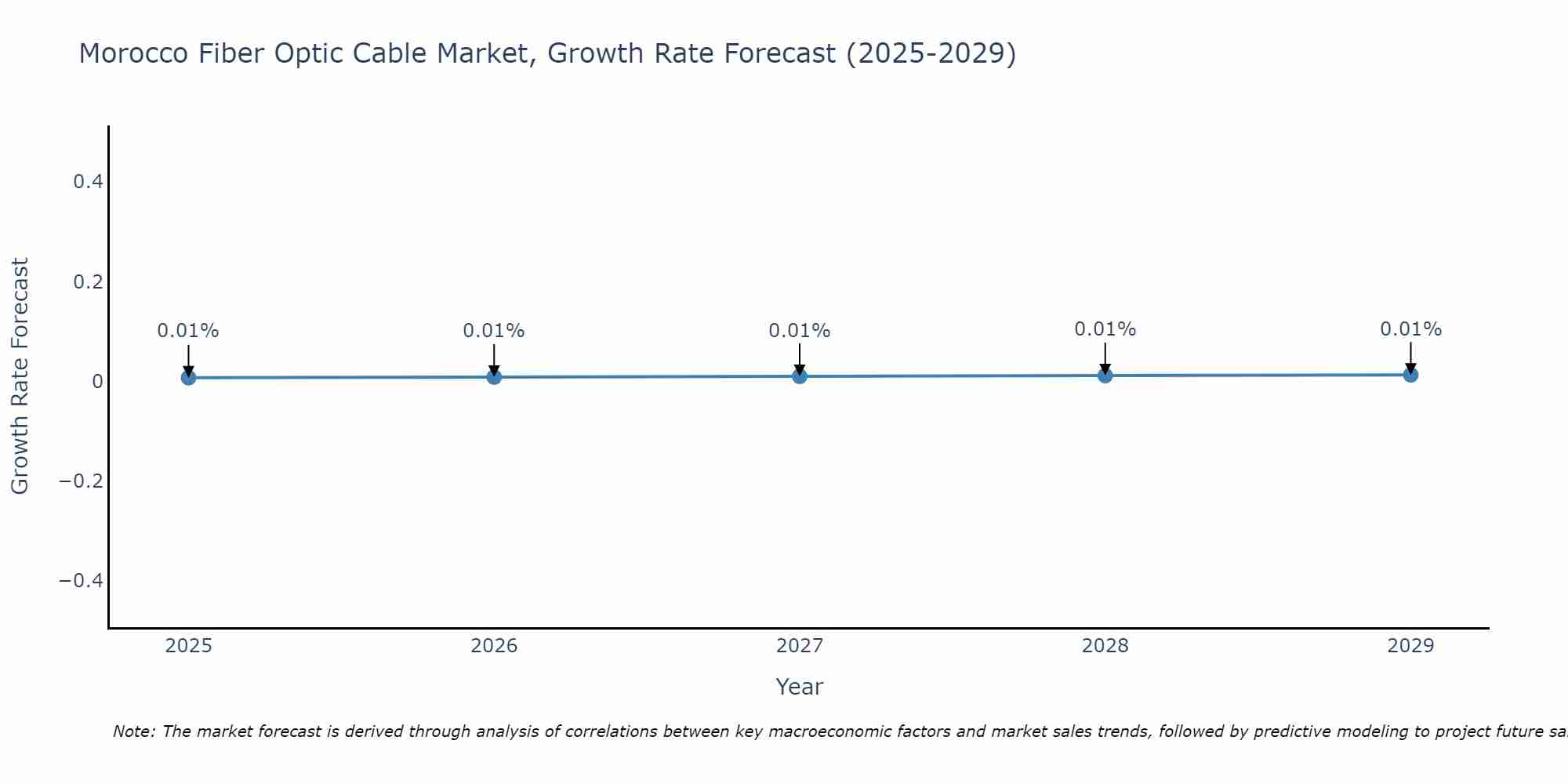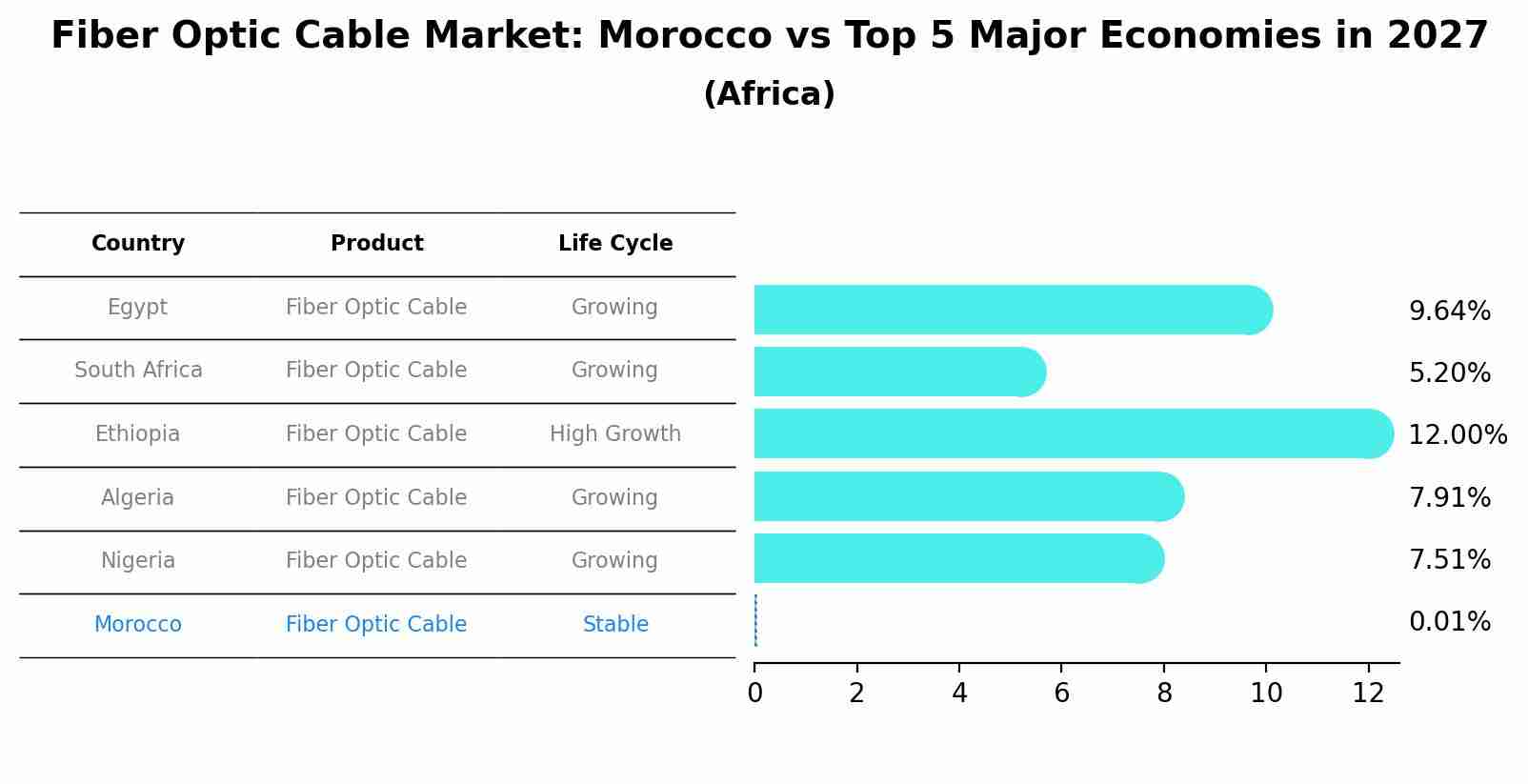Morocco Fiber Optic Cable Market Outlook | Industry, Size, Forecast, Analysis, Trends, Revenue, COVID-19 IMPACT, Companies, Value, Growth & Share
| Product Code: ETC364013 | Publication Date: Aug 2022 | Updated Date: Aug 2025 | Product Type: Market Research Report | |
| Publisher: 6Wresearch | Author: Ravi Bhandari | No. of Pages: 75 | No. of Figures: 35 | No. of Tables: 20 |
Morocco Fiber Optic Cable Market Size Growth Rate
The Morocco Fiber Optic Cable Market is poised for steady growth rate improvements from 2025 to 2029. Commencing at 0.01% in 2025, growth builds up to 0.01% by 2029.

Fiber Optic Cable Market: Morocco vs Top 5 Major Economies in 2027 (Africa)
In the Africa region, the Fiber Optic Cable market in Morocco is projected to expand at a stable growth rate of 0.01% by 2027. The largest economy is Egypt, followed by South Africa, Ethiopia, Algeria and Nigeria.

Morocco Fiber Optic Cable Market Synopsis
The Morocco Fiber Optic Cable Market is experiencing significant growth driven by the increasing demand for high-speed internet and advanced communication networks. The market is witnessing a surge in investments in telecommunications infrastructure, data centers, and smart city projects, which are fueling the adoption of fiber optic cables. Key players in the market are expanding their product offerings to cater to the growing demand for reliable and high-performance network solutions. Government initiatives to improve connectivity and digital infrastructure are also contributing to the market growth. Additionally, the rising awareness about the benefits of fiber optic technology, such as faster data transmission, lower latency, and higher bandwidth capacity, is further driving the market expansion in Morocco.
Morocco Fiber Optic Cable Market Trends
In the Morocco Fiber Optic Cable Market, one of the current trends is the increasing demand for high-speed internet connectivity across both urban and rural areas. This demand is driven by the growing adoption of digital technologies, such as cloud computing, IoT devices, and online streaming services. Additionally, the government`s initiatives to improve broadband infrastructure and expand internet access are further fueling the demand for fiber optic cables in the country. Another trend is the rising deployment of fiber-to-the-home (FTTH) networks by telecom operators to provide faster and more reliable internet services to residential customers. As a result, there is a surge in investments in fiber optic cable infrastructure to meet the escalating need for efficient and high-capacity data transmission in Morocco.
Morocco Fiber Optic Cable Market Challenges
In the Morocco Fiber Optic Cable Market, several challenges are faced, including high installation costs associated with deploying fiber optic infrastructure, limited availability of skilled technicians for maintenance and repair, and the need for continuous investment in upgrading technology to keep pace with evolving industry standards. Additionally, regulatory hurdles and bureaucratic processes can slow down the expansion of fiber optic networks in Morocco. Competition from alternative technologies such as wireless networks also poses a challenge to the growth of the fiber optic cable market in the country. Overall, overcoming these challenges will require strategic partnerships, investment in training programs, streamlined regulatory processes, and a strong focus on innovation to drive the adoption of fiber optic technology in Morocco.
Morocco Fiber Optic Cable Market Investment Opportunities
The Morocco Fiber Optic Cable Market presents promising investment opportunities due to the increasing demand for high-speed internet services, driven by the growing digitalization of businesses and households. With the government`s initiatives to improve the country`s digital infrastructure and connectivity, there is a significant need for expanding and upgrading the existing fiber optic network. Investors can consider opportunities in manufacturing and supplying fiber optic cables, installation and maintenance services, as well as partnerships with telecommunications companies for network expansion projects. Additionally, the potential for future growth in sectors like telecommunication, IT, and healthcare further enhances the attractiveness of investing in the Morocco Fiber Optic Cable Market. Conducting thorough market research and understanding the regulatory environment will be crucial for successful investment in this sector.
Jordan Agar Market Government Policies
The Moroccan government has been actively promoting the expansion and development of the fiber optic cable market through various policies and initiatives. In 2015, the National Broadband Plan was launched with the goal of increasing broadband penetration and improving internet connectivity across the country. Additionally, the government has implemented measures to attract foreign investment in the telecommunications sector, including offering tax incentives and streamlined regulations for companies operating in the fiber optic industry. Furthermore, initiatives such as the deployment of fiber optic networks in rural areas and partnerships with private sector companies have been introduced to bridge the digital divide and ensure widespread access to high-speed internet services. Overall, the government`s policies aim to stimulate growth and innovation in the Moroccan fiber optic cable market while enhancing the country`s digital infrastructure.
Morocco Fiber Optic Cable Market Future Outlook
The future outlook for the Morocco Fiber Optic Cable Market appears promising due to several key factors. The increasing demand for high-speed internet and data services, driven by the growth of digital transformation initiatives, e-commerce, and cloud computing, is expected to fuel the adoption of fiber optic cables in the country. Additionally, government investments in expanding the telecommunications infrastructure, including initiatives such as the National Broadband Plan, are likely to boost the deployment of fiber optic networks. The ongoing trend towards 5G technology and smart city development projects further create opportunities for the fiber optic cable market in Morocco. Overall, with the growing need for faster and more reliable connectivity, the Morocco Fiber Optic Cable Market is anticipated to experience steady growth in the coming years.
Key Highlights of the Report:
- Morocco Fiber Optic Cable Market Outlook
- Market Size of Morocco Fiber Optic Cable Market, 2021
- Forecast of Morocco Fiber Optic Cable Market, 2031
- Historical Data and Forecast of Morocco Fiber Optic Cable Revenues & Volume for the Period 2018 - 2031
- Morocco Fiber Optic Cable Market Trend Evolution
- Morocco Fiber Optic Cable Market Drivers and Challenges
- Morocco Fiber Optic Cable Price Trends
- Morocco Fiber Optic Cable Porter's Five Forces
- Morocco Fiber Optic Cable Industry Life Cycle
- Historical Data and Forecast of Morocco Fiber Optic Cable Market Revenues & Volume By Cable Type for the Period 2018 - 2031
- Historical Data and Forecast of Morocco Fiber Optic Cable Market Revenues & Volume By Single-Mode for the Period 2018 - 2031
- Historical Data and Forecast of Morocco Fiber Optic Cable Market Revenues & Volume By Multi-Mode for the Period 2018 - 2031
- Historical Data and Forecast of Morocco Fiber Optic Cable Market Revenues & Volume By Material for the Period 2018 - 2031
- Historical Data and Forecast of Morocco Fiber Optic Cable Market Revenues & Volume By Glass for the Period 2018 - 2031
- Historical Data and Forecast of Morocco Fiber Optic Cable Market Revenues & Volume By Plastic for the Period 2018 - 2031
- Historical Data and Forecast of Morocco Fiber Optic Cable Market Revenues & Volume By Application for the Period 2018 - 2031
- Historical Data and Forecast of Morocco Fiber Optic Cable Market Revenues & Volume By Communication for the Period 2018 - 2031
- Historical Data and Forecast of Morocco Fiber Optic Cable Market Revenues & Volume By Power Transmission for the Period 2018 - 2031
- Historical Data and Forecast of Morocco Fiber Optic Cable Market Revenues & Volume By Sensor for the Period 2018 - 2031
- Historical Data and Forecast of Morocco Fiber Optic Cable Market Revenues & Volume By Others for the Period 2018 - 2031
- Morocco Fiber Optic Cable Import Export Trade Statistics
- Market Opportunity Assessment By Cable Type
- Market Opportunity Assessment By Material
- Market Opportunity Assessment By Application
- Morocco Fiber Optic Cable Top Companies Market Share
- Morocco Fiber Optic Cable Competitive Benchmarking By Technical and Operational Parameters
- Morocco Fiber Optic Cable Company Profiles
- Morocco Fiber Optic Cable Key Strategic Recommendations
Frequently Asked Questions About the Market Study (FAQs):
- Single User License$ 1,995
- Department License$ 2,400
- Site License$ 3,120
- Global License$ 3,795
Search
Thought Leadership and Analyst Meet
Our Clients
Related Reports
- Germany Breakfast Food Market (2026-2032) | Industry, Share, Growth, Size, Companies, Value, Analysis, Revenue, Trends, Forecast & Outlook
- Australia Briquette Market (2025-2031) | Growth, Size, Revenue, Forecast, Analysis, Trends, Value, Share, Industry & Companies
- Vietnam System Integrator Market (2025-2031) | Size, Companies, Analysis, Industry, Value, Forecast, Growth, Trends, Revenue & Share
- ASEAN and Thailand Brain Health Supplements Market (2025-2031) | Strategy, Consumer Insights, Analysis, Investment Trends, Opportunities, Growth, Size, Share, Industry, Revenue, Segments, Value, Segmentation, Supply, Forecast, Restraints, Outlook, Competition, Drivers, Trends, Demand, Pricing Analysis, Competitive, Strategic Insights, Companies, Challenges
- ASEAN Bearings Market (2025-2031) | Strategy, Consumer Insights, Analysis, Investment Trends, Opportunities, Growth, Size, Share, Industry, Revenue, Segments, Value, Segmentation, Supply, Forecast, Restraints, Outlook, Competition, Drivers, Trends, Demand, Pricing Analysis, Competitive, Strategic Insights, Companies, Challenges
- Europe Flooring Market (2025-2031) | Outlook, Share, Industry, Trends, Forecast, Companies, Revenue, Size, Analysis, Growth & Value
- Saudi Arabia Manlift Market (2025-2031) | Outlook, Size, Growth, Trends, Companies, Industry, Revenue, Value, Share, Forecast & Analysis
- Uganda Excavator, Crane, and Wheel Loaders Market (2025-2031) | Strategy, Consumer Insights, Analysis, Investment Trends, Opportunities, Growth, Size, Share, Industry, Revenue, Segments, Value, Segmentation, Supply, Forecast, Restraints, Outlook, Competition, Drivers, Trends, Demand, Pricing Analysis, Competitive, Strategic Insights, Companies, Challenges
- Rwanda Excavator, Crane, and Wheel Loaders Market (2025-2031) | Strategy, Consumer Insights, Analysis, Investment Trends, Opportunities, Growth, Size, Share, Industry, Revenue, Segments, Value, Segmentation, Supply, Forecast, Restraints, Outlook, Competition, Drivers, Trends, Demand, Pricing Analysis, Competitive, Strategic Insights, Companies, Challenges
- Kenya Excavator, Crane, and Wheel Loaders Market (2025-2031) | Strategy, Consumer Insights, Analysis, Investment Trends, Opportunities, Growth, Size, Share, Industry, Revenue, Segments, Value, Segmentation, Supply, Forecast, Restraints, Outlook, Competition, Drivers, Trends, Demand, Pricing Analysis, Competitive, Strategic Insights, Companies, Challenges
Industry Events and Analyst Meet
Whitepaper
- Middle East & Africa Commercial Security Market Click here to view more.
- Middle East & Africa Fire Safety Systems & Equipment Market Click here to view more.
- GCC Drone Market Click here to view more.
- Middle East Lighting Fixture Market Click here to view more.
- GCC Physical & Perimeter Security Market Click here to view more.
6WResearch In News
- Doha a strategic location for EV manufacturing hub: IPA Qatar
- Demand for luxury TVs surging in the GCC, says Samsung
- Empowering Growth: The Thriving Journey of Bangladesh’s Cable Industry
- Demand for luxury TVs surging in the GCC, says Samsung
- Video call with a traditional healer? Once unthinkable, it’s now common in South Africa
- Intelligent Buildings To Smooth GCC’s Path To Net Zero


















